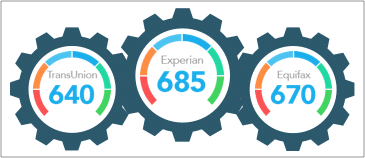The journey to getting your credit health in tip-top shape takes preparation and persistence. It starts with taking a hard look at where you stand, determining where you’d like to land – and mapping out a course of action with timely checkpoints along the way to keep you on the right path.
Use this Credit Health Guide to help you map out what to do – and when to do it:
ANNUALLY:
- Assess your financial reality. Do the math (and re-evaluate each year) so you know exactly what’s coming in and what’s going out.
- Outline your annual income streams.
- Confirm your existing debts, insurance rates and interest rates.
- Track your spending. If you have more going out than coming in, you know you’ve got a problem.
- Check your credit scores and reports to gain a solid understanding of your current credit standing and to factor it into how your scores could impact your future credit needs and debt repayment plans.
- Make a budget based on your findings – and a savings plan. In addition to your monthly expenses, don’t forget to include items that occur regularly, but not every month, such as vehicle maintenance and healthcare expenses. List “savings” as a fixed expense in your budget plan – and “pay it” every month as you would other monthly debts. Automated deposits into your savings account can help offset the temptation to spend that money.
- Plan ahead for big-ticket purchases that require years of financing. If you’re considering a mortgage, auto, personal, home improvement or college loan – ask yourself these questions:
- When will you make the purchase … what month?
- How much of a monthly payment can you afford?
- How big a down payment are you prepared to make?
- Will your credit scores be at their best when you apply for financing?
- Reduce your debt wherever possible. This improves your credit scores – and is particularly important to do before you apply for a loan. Higher scores will earn you better interest rates. To make a dent in your debt:
- Pay off the balances on your credit cards, or at least get your balances down to 10% of your card limit.
- Pay more than the minimum due every month. Every extra dollar pays down the principal balance.
- Make extra payments when possible. You’ll save a lot in interest and drastically cut your pay-off time!
- Pay early or on-time every time. Late payments and fees will cost you and undo all your hard work.
- Don’t incur new debt if at all possible. Pay with cash, or if you must use a credit card, pay it off immediately when the bill comes due.
QUARTERLY:
- Assess your new budget to determine what’s working and what’s not. Have you had any additional revenue or unexpected expenses? How have you adjusted for that?
- Evaluate your progress in getting “loan-ready.”
- Are you on track to hit your big-ticket purchase goal?
- Have you been saving for a down payment?
- Does the potential monthly payment amount you budgeted still work?
- Will your credit scores qualify you for the interest rate you need to get that payment amount?
- Do a reality check on your debt repayment efforts.
- Are you making progress in reducing your debt?
- Do you reinvest those funds in a savings account or throwing more at your credit card balances?
- Have you stayed true to “cash is king” shopping?
- If you’ve had to incur new debt, did you make trade-offs in your budget to pay it off immediately?
MONTHLY:
- Check your credit scores and reports to monitor your progress.
- Do your scores reflect your progress in reducing your debt?
- Are your scores reflecting that no new debt has been incurred?
- Can your scores qualify you for lower interest rates on existing credit cards right now?
- Are your scores moving in the right direction to get the best interest rate on big-ticket financing?
- Monitor your credit reports for signs of identity theft. Unauthorized activity could indicate your personal information is being sold on the black market to commit ongoing identity theft and fraud.
- Monitor your credit reports for errors or outdated information. It is important to verify that all the information on your credit reports is accurate and up to date to protect your scores. Don’t forget that one in five people have an error on their credit reports that can affect their scores, and outdated information, especially score-lowering errors, can cost you loan approval or trigger higher interest rates.
Having good credit is a powerful tool that can help make your financial life easier to navigate year after year. Whether you need to build it up, pay it down, get it back on track or maintain and protect it, the key to optimizing your credit health is patience, persistence – and a year-round plan!



